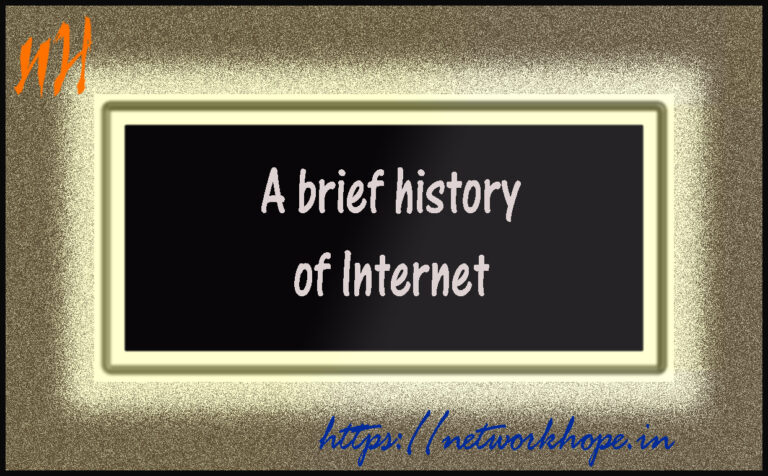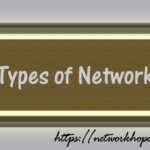What is a Network ?
Introduction and a brief history of Network: A network is essentially a connection of two or more devices to share the information and resources. The resources may be hardware or software. All the components, including the communication media and the programs or software, are an essential part of the network.
The hardware may be as small as a handheld device, or a giant Supercomputer, altogether, they comprise the network. There are various networking devices like the hub, switch, router, gateway, and of course, the connecting media- which as a whole represents the hardware. The software is the part that allows the device to communicate, facilitate the users to talk, or you may say they make the devices talk to each other.
The network which we see today is in exponential form, no doubt when you see it with the perspective of a person in the 1960s. Though today, if you consider the concept of IoT, Extra-Terrestrial Network, etc. you may feel the network has yet to witness its highest boom.
A brief history of Network
Let us trace back to the earlier days, when computers were operating individually, or stand alone as they are referred to as. It was around the 1960s when they thought there is a need for communication between those devices. Thanks to the US Department of Defense (DoD), the project ARPA (Advanced Research Project Agency) took the initiative and come up with a solution by 1969 as ARPANET.
By 1969, the ARPANET was able to connect four mainframe computers. ARPANET had combined four Universities of the US with four Mainframe computers. The network used the software called Network Control Protocol (NCP), which provided communication between the hosts.
In 1972, two pioneers from project ARPA – Vint Cerf and Bob Kahn collaborated for a project Internetting Project, as they call it. The overall purpose was to establish a connection between the networks. As there was no standard protocol, they came up with the idea of Gateway between diverse networks to communicate with each other. Since there was no standard for the packet size, transmission-techniques, interfaces, etc., it was a complete innovation of networking between the diverse networks.
This duo finally devised the idea, which we now call TCP/IP. They come up with a new version of NCP as TCP (Transmission Controlled Protocol).
In 1977, an Internet between three different networks was successfully demonstrated. Now you may understand the significance of the name InterNet. It was the first effort to communicate between the Nets. The participating Networks were ARPANET, Packet Radio & Packet Satellite.
Shortly after that, they split TCP into TCP (Transmission Controlled Protocol) and IP (Internet Protocol). Now TCP/IP is the name which we are very familiar with, is a suite of 2 protocols. And of course, its the backbone of the worldwide network that we call the Internet today.
TCP/IP becomes the formal standard
In 1983, ARPANET adopted TCP/IP as a communication Protocol and dropped the NCP they used earlier. So, Vint Cerf and Robert Elliot Kahn (Bob Kahn) invented TCP/IP, which eventually opens the path for the growth of the Internet.
In the same year, ARPANET thought of giving access to people apart from those related to the military. ARPANET then split into MILNET (Military Net) and ARPANET.
By the time NSF (National Science Foundation) already had come up with CSNET (Computer Science Network) for the department of academics and research. Since then, ARPANET was exclusive for DoD only. CSNET extended to US Universities with Computer Science Departments. That era was the start of networking outside the military domain. Later in 1986, NSFNET was formed, which connected 5 Supercomputer centers throughout the US.
Just imagine, with the current perspective, the five supercomputer centers were connected by a very high-speed line then of 1.544 Mbps (T1). The bandwidth that doesn’t even qualify for connectivity of hand-held device today.
In 1990 ARPANET officially handed it over to NSFNET. Later, NSFNET also shifts focus to its original field of Research. By 1991, a nonprofit organization called Advanced Network and Services started ANSNET. ANSNET comprised of three companies- IBM, MCI, and Merit.
You are reading the topic: Introduction and a brief history of Network
The Internet
The Internet today is a combined network of several heterogeneous LAN, MAN, and WAN in a single web. There are ISP’s (Internet Service Providers) who provide the services to the user. The telecom industries provided a communication link like PSTN (Public switched Telephone Network), DSL (Digital Subscriber Line), ADSL (Asymmetric- DSL), FTTH (Fiber to the home), etc.
There are ISP’s at various levels, The backbone ISP’s, the regional and the local ISP’s.
The World Wide Web
Though the Internet is the connectivity, the services on the Internet are equally important. One cannot make use of the connectivity unless there are no services.
The most widely used service, the world wide web (WWW), was invented by Tim Berners Lee in 1990. Now, if you can browse (or surf, Navigate) the net, it’s only due to the WWW service.
Similarly, the other services on the Internet are IRC (Internet Relay Chat), eMail, Telnet (A remote logging service), e-commerce, or social media nowadays, etc. These services on the Internet makes it a complete package of entertainment, education, trading, or collaborating the people worldwide.
So, the Internet today came via so many alterations, standards, inventions, dedication, and the interest of people involved in it. The Internet is the largest network today, which is expanded worldwide and still growing.
Web 2.0
However, the WWW of ’90s was web 1.0 now we are in the dynamic web, i.e., web 2.0. In a short note, I would like to say that Web 2.0 is all about the dynamic web, where the content changes dynamically. You can see the cricket score with an automatic update without the need of refreshing pages. Again, other features like people commenting on forums, blogs, or Social media, or contributing to the wikis are also the outcome of Web 2.0.
The first generation web sites were the static pages, just like a notice board of the college. Like the College publishes only those materials, which they would like to share with anonymous people, and anybody passing by can see the message.
Now, there are credentials, privileges, authentication methods, encryption, etc. We will come to those things one by one in upcoming blogs.
You have just finished reading the topic: Introduction and a brief history of Network. Please don’t forget to share this article among your contacts. Feel free to write in the comment box below.
Thank you for reading. You may mail me from here: Contact Admin
Take a Quiz of this topic :



The information received about Web 2.0 is completely new.
thanx Sir… 🙏
Keyboard is not working in putty serial connection